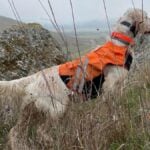
Home » The Finnish Lapphund: A Breeder’s Perspective

This article was originally published in Showsight Magazine, April 2013 issue.
The Finnish Lapphund originated with the nomadic Saami people in Lapland, primarily north of the Arctic Circle. Lapland encompasses the northern regions of Finland, Sweden, and Russia. The Saami relied on reindeer as a vital source of food and clothing. They kept herds and followed them from grazing area to grazing area, with the Finnish Lapphund serving as a medium-sized herder and an all-around working dog around their camps. Interestingly, the Samoyed also originated in the same region and with the same people.
Reindeer in Lapland are domesticated and generally do not fear dogs. However, a Finnish Lapphund that gets too close risks being kicked or scooped by the reindeer’s antlers. To manage these challenges, the breed was developed to bark and bounce energetically to get the herd moving. In Finland, Lappies competing in Reindeer Trials are disqualified if they fail to bark.
Unlike most domestic dogs today, which descend from the Asian wolf, recent research in Scandinavia has revealed that over 80% of the Finnish Lapphund’s mitochondrial DNA comes from the Arctic Wolf. These crosses with the Arctic Wolf are believed to have occurred as recently as 400 to 1,000 years ago. In the United States, the first documented Finnish Lapphunds were imported in 1987, with the first litter born around 1988.
Finnish Lapphunds are a northern breed, classified as working/herding Spitz. Their appearance is characteristic of most northern breeds, from ears to tail, with a distinctive silhouette, including the tail carried over the back. Similar to the Samoyed but shorter in stature and with a slightly longer back, the Lappy comes in a rainbow of colors, including black, brown, shades of cream from off-white to golden, as well as wolfsable and domino. Tan points may appear on the face and legs or only on the legs. Many dogs have spectacles, either with or without the tan pattern markings. Solid colors are also allowed, though brindle, piebald, and saddle patterns are ‘frowned upon.’
Lappies are longhaired, double-coated dogs that typically shed twice a year. They should have a stocky, sturdy appearance, looking heavier than they are. Their profuse, standoff coat and comparatively heavy bone contribute to this look. Physically, the Lappy should be quick and agile, able to turn on a dime and change speed or direction instantly.
Finnish Lapphunds succeeded as reindeer herders by dropping quickly to the ground in response to a reindeer’s kick or antler swipe. The Breed Standard specifies a ‘working height’ that allows the dog to drop beneath the hooves or antlers of a reindeer. A taller dog would lack the speed and ability to drop low in an emergency. Natural selection favored dogs within the height range of 16″-19″ for females and 18″-21″ for males, with the ideal heights being 17½” for females and 19½” for males. Typical weights range from approximately 30-38 pounds for females and 37-45 pounds for males, with some variation.
The Finnish Lapphund is generally a healthy breed with few issues. While the incidence of problems is low, breeding or performance dogs should have OFA certification for hips, knees, and elbows. Responsible breeders also have dogs examined by a canine ophthalmologist to screen for cataracts or other eye issues and confirm PRA (progressive retinal atrophy) gene status through genetic testing. With the PRA test, there is no excuse for producing affected puppies. Finnish Lapphunds typically live 12-15 years or longer.
This breed is gentle, affectionate, non-aggressive, and highly accepting of human leadership. They are often described as submissive, meaning they are not inclined to challenge humans, but this does not equate to timidity. Finnish Lapphunds aim to please their owners and lack the stubbornness often associated with Spitz breeds. They are also not prone to dog aggression and generally enjoy the company of other dogs, especially those of their own breed. Their temperament is exemplary. While two males might briefly clash over a female in season, such occurrences are rare, and the breed does not have a propensity for serious quarrels.
Lappies are highly interactive in their play. They love to share toys, whether a stuffed animal or a stick in the backyard. It’s common to see two, three, or more Lappies carrying the same large stick, trotting in unison. They will even stop, turn, and offer the stick to another dog, slowing down so it can catch up with them.
Finnish Lapphunds are a very kind, warmhearted breed. Their gentleness is legendary. Lappies recognize the needs or abilities of the people around them and adjust their energy accordingly. A Lappy will become calm and slow-moving around a baby or someone with a disability, while a vigorous person would see a higher energy level from the same dog.
These dogs love children and show an intuitive ability to adapt to a toddler’s needs. They will sit or drop down low, even laying down, so that they do not appear threatening to a young child. This is an automatic response to a child they have not met before. Even young Lappies will do this.
Finnish Lapphunds are extremely intelligent, highly adaptable, and have been used for everything from herding to agility, tracking, obedience, conformation, and therapy work. In Europe, they are even used as guide dogs for the blind. They are bright, quick to learn, and eager to please.
Finnish Lapphunds in the US have earned Agility titles, including a MACH, Obedience titles, Herding Instinct Certificates, Therapy Dog certification, and even a Tracking title with Versatility recognition. Their ability to learn and succeed seems limited only by what their owners want to do with them.
This breed is so intelligent that they frequently learn commands by watching another dog. For example, they might see another dog in class or ringside getting a treat for a behavior, and suddenly the Lappy will begin offering that behavior too. They are masters at observational learning and can quickly pick up skills from other dogs.
Because of their intelligence, Finnish Lapphunds should be trained to do something—it can be anything. Without mental stimulation, they may become bored and look for their own “interesting” activities. Structure and training can help teach them useful behaviors.
Some Lappies have a retrieving instinct, while others do not. However, they are very quick to learn tricks for a reward and love to earn treats by showing off their new skills.
Many breeders of large breeds who show their own dogs will tell you that, after decades of showing, training, and whelping litters, they often seek out a smaller breed. After breeding and showing Akitas for 17 years—and experiencing an auto accident that ruptured several disks in my back—I needed to find a smaller, athletic breed.
I wanted a northern breed that was small enough to pick up if needed, yet athletic and agile, with a long lifespan and good overall health. Additionally, I sought a breed with a consistently sweet temperament, no tendency for dog aggression, high intelligence, and a willingness to please. With my preference for the northern Spitz-type look, this was a tall order. Fortunately, I discovered the Finnish Lapphund and never looked back.
Finnish Lapphunds make wonderful watchdogs because they will bark at strangers or unusual activity. However, the degree of barking varies from dog to dog. If you live in an area where barking could be an issue, it’s important to know that this breed is trainable and can learn to limit their barking if instructed. That said, they may not be the best fit for apartment living. A sweet and trusting breed, Finnish Lapphunds love other dogs and crave canine companionship. As a northern breed with some independence, they do best with a securely fenced yard or when kept on a leash. Whether you enjoy outdoor activities, participate in dog sports like conformation or tracking, or simply want a quiet evening at home, this breed can adapt beautifully and makes a wonderful companion.